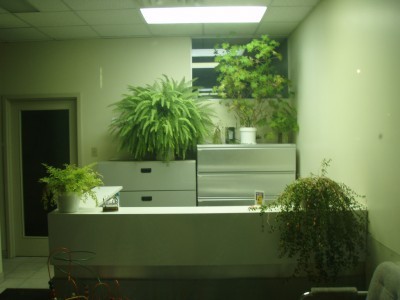






Office plants are often the most frequent victims of well intentioned neglect. They are watered regularly and fed occasionally, but as they grow, very little thought is given as to how long the plant has been in the same pot or how big the plant has grown. Sooner or later, the plant’s health starts to fail and no amount of proper watering and fertilizer can help an overgrown plant with its current problems.
When a plant is dying from this kind of neglect, it needs some immediate TLC of another kind to bring the plant back. Let’s look at how to revive a plant and how to how to replant a potted plant.
One of the first steps you need to take for reviving plants is to prune both the top and the roots of the plant.
If an overgrown plant is failing, there is a good chance that the plant is suffering from being root bound. Root bound is a condition where the roots have grown so tightly that they have started to tangle in on themselves. In some advanced cases, you will find that the soil in an overgrown plant’s pot has been replaced with roots.
There is no easy way to untangle a root bound plant’s roots, but fortunately, a plant is designed to regenerate itself. The easiest way to fix an overgrown plant’s roots is to prune them.
Start by taking the plant out of the pot. On the bottom of the compacted rootball, make a clean X about a quarter of the way into the rootball with a sharp knife. Tease apart the roots and remove any roots that have been cut loose. If you run into any sections that do not tease apart, repeat the process with that section. Keep going until the plants root ball is again loose and healthy.
The next step for reviving plants is to prune the top of the plant. Using a sharp pair of scissors or pruning shears, trim away any old growth on the plant. This is typically characterized by woody growth and sparse leaves. This growth may be tough to cut, so be careful.
Next, remove any sickly growth on the overgrown plant. This is characterized by yellow leaves or a wilted appearance.
Be sure to leave young growth in place. Young growth will be tender looking and typically comes directly from the rootball. The young growth can have partial yellow leaves or brown edges on the leaves. This is okay and should repair itself once the plant it settled in its new pot.
The next step in how to bring a plant back is to repot it. Find a pot that is 1 to 3 inches larger around than the rootball. Fill the pot half way with potting soil and then put an additional scoop of soil in the center of the pot, so you have a mound. Spread the roots of the plant over the soil mound and fill the pot until the roots are covered and the plant is sitting at the same level it was before.
Water thoroughly to make sure there are no air pockets. Fill in the soil as necessary.
Now that you know how to revive a plant, you can enjoy your house and office plants for many years to come. Better than reviving plants is never having to worry about it. Make repotting and pruning your indoor plants a yearly task and you will reduce the chances that you need to bring a plant back from near death.
Copyright © www.100flowers.win Botanic Garden All Rights Reserved